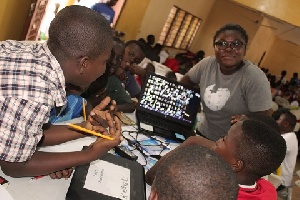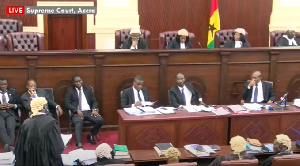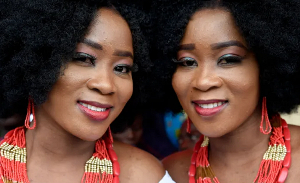Opinions of Thursday, 4 April 2024
Columnist: Nicholas M. Gborse
Standard-based curriculum implementation: Digital literacy and ICT myths among some teachers
The Ministry of Education and its partners have rolled out the Common Core Curriculum at the Basic and Junior High School levels.
In the latter part of this year, stakeholders such as the GES, NTC, NaCCA and their partner organization, T-TEL, will be rolling out the Standard-Based Curriculum for all SHSs/SHTSs/STEM institutions.
Ahead of this, teachers are being prepared [through Professional Learning Community sessions] in some crosscutting issues and teaching strategies. As well as GESI, SEL, SEN and 21st-century skills, other crosscutting issues of focus in the new curriculum are differentiation, scaffolding and the elephant in the room- digital literacy and ICT Integration.
More than ever, the MOE and its agencies such as the GES, NaCCA and the NTC as well as partners such as T-TEL and Ghana Society for Education Technology [GSET] are investing a lot of energy, time and resources in equipping the teachers ahead of the official roll out of the curriculum later this year. The application of Digital Literacy and ICTs in the Common Core Curriculum and the Standard Based Curriculum is an important departure from the Objective Based Curriculum.
As an EdTech advocate and someone who has led advocacy for EdTech in the pre-tertiary education space for over a decade, I am enthused with these groundbreaking innovations that have the potential to change the essence and relevance of education to our learners. There are, however, some misconceptions about ICTs and digital literacy among some teachers that we must all work to clear in order to pave the way for the successful implementation of the curriculum.
On the 22nd of March, 2024, I had the opportunity to interact with some teachers in my bid to gauge their appreciation and use of digital literacy and ICTs in the classroom. I had some interesting feedback from them. One young lady teacher who may be in her mid-twenties and who told me she teaches class one at a school in the North Dayi District was my first interviewee.
I sought to find out from her the extent to which she and her colleagues make use of ICTs and digital literacy in teaching and learning. Her response? “Oh, at the lower level too? Me, I teach class one, so I don’t use that,” were her polite and honest responses to me. When I tried to draw her attention to the fact that digital literacy use at that level is even more of fun and that it will help to enrich her content and pedagogical strategies, she agreed with me. Her concern, however, was that she did not have the ICT equipment.
My second interviewee was a young lady teacher in her thirties. She teaches at a school in the Ho Central Municipality although her school lies at the outskirts of the capital. I began my unstructured and casual interview with her by asking her the grade she teaches. She told me that she teaches class five. Even though I know that as a class teacher, she teaches almost all the learning areas or subjects in that grade, yet, I still asked her what her best subject was. She then told me that she likes Creative Arts and Design as she is a Fashion Designer, besides teaching. I became interested as I was happy that she is multi-tasking, multi-talented and entrepreneurial.
In the midst of my curiosity, I asked her how she came by her skills in fashion designing, and the response I got was pleasant and encouraging to me. She told me that even though she offered Clothing and Textiles in the Secondary School as a Home Economics student, she learnt much of what she now does as a fashion designer through YouTube videos. I was appreciative of her effort and ingenuity. Her kind response then led me to ask her my next question: “To what extent are you using digital literacy and ICTs in teaching and learning”? The response was intriguing, but not entirely surprising. Her response? “Me, I don’t know anything about digital literacy and ICTs oo.”
When I tried to remind her that her use of YouTube videos to teach herself various skills in fashion designing constitutes a digital literacy application that she can leverage in her classroom, she then opened another can of worms. This time, she told me that she does not have a projector for teaching. She, however, told me that some of her colleagues in the JHS teach using digital literacy and ICTs. I concluded my discussion or is it an interview with her, but not on a disappointing note. I was encouraged that she is willing to learn as she indicated that she would contact her JHS colleagues to let them teach her how they deploy digital literacy skills in teaching and learning.
Even though these responses sound interesting, they are not far-fetched. They underscore the myths that still surround the application of digital literacy and ICTs in our schools. The foremost of the myths is that digital literacy and ICTs are not suitable for lower grades such as preschool and primary or basic schools. While this myth may not be the case among all teachers at this level, it is trite knowledge that some facilitators or teachers at these levels hold this view.
The second myth among some teachers is that ICTs and digital Literacy use is all about what Mr Miraucle Gavor, the Executive Director of Ghana Society for Education Technology [GSET] while re-echoing the perceptions of some teachers refers to as “projectors, laptop and PowerPoint.” He holds the view that many teachers erroneously reduce digital literacy and ICT use of PowerPoint presentations and possession of laptops and projectors. Hence, they are quick to complain that in the absence of these teacher-learner resources [TLRs], they are unable to use ICTs in teaching and learning. Meanwhile, GSET is an EdTech company with a foothold in all 16 regions, and that is partnering with many agencies in the deployment of digital literacy in Ghanaian schools.
Another myth is that although some teachers are conversant with social media platforms such as Facebook, YouTube, Instagram and X formerly Twitter which they use for fun, they do not appreciate the use of same platforms for teaching and learning. Their challenge is that they are not able to identify, download and convert some of these resources into TLRS in their teaching and learning to enrich their pedagogies or contents. Others also think that the whole issue of digital literacy and ICT use is something humongous that they do not have any idea about although they use social media daily.
A final myth is that some facilitators do not appreciate the point that their mobile phones some of which are very sophisticated can constitute an important first port of call for them in the matter of digital literacy use. Accordingly, many of us are underutilizing our mobile phones.
How then do we address these myths or are they challenges? First, all stakeholders including GSET, GES, NTC, T-TEL should work towards attitudinal change among teachers. There is a need for education for some segments of our teachers to better embrace and understand the use of these platforms and TLRs.
There is a need for orientation and reorientation for some other segments of teachers to reckon that education delivery in the 21st century requires digital literacy skills and competence and that it is not something that is being imposed on them from Accra. Such forums must highlight the benefits of digital literacy to the facilitators and the learners alike. Also, training needs must target teachers’ mobile phones. Teachers must be exposed to the digital benefits in the use of their mobile phones and personal laptops.
There is a need for targeted in-person and remote workshops for teachers in the use of AI tools and other digital resources for learning. Stakeholders should encourage schools to leverage the ongoing Professional Learning Community [PLC] sessions to do a lot of hands-on application and use of digital resources including AI tools. Some teachers also require support in how to locate resources, contents and knowledge in their learning areas.
Thus, AI and digital resource location should be both generic and learning area-specific and target individual subjects. Finally, stakeholders should equip the schools with resources such as projectors and laptops in order to encourage ICT deployment in our schools.
In summary, stakeholders ought to collaborate to ensure that teachers’ digital needs are addressed and digital literacy is placed on the front burner of the Standard Based Curriculum [SBC] implementation.













